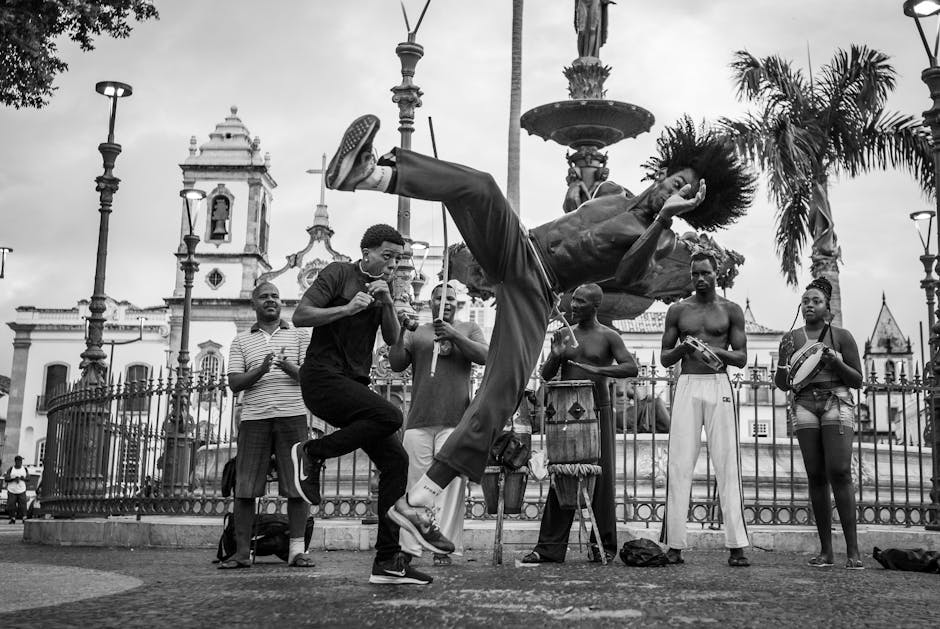The Brazilian flag serves as a significant emblem of national identity, reflecting the rich history and culture of Brazil. It was officially adopted on November 19, 1889, shortly after the proclamation of the Republic. This adoption marked a critical transition from the Empire of Brazil, represented by the previous flag, to a new republic that sought to symbolize unity and diversity among its people.
The design of the Brazilian flag is thoughtful and symbolic, with its distinctive green field adorned by a large yellow diamond, which frames a blue globe studded with 27 white stars. Each star on the globe signifies one of the country’s federative units, thus highlighting Brazil’s federal structure. The green backdrop is traditionally associated with the House of Braganza, while the yellow diamond represents the House of Habsburg, as a nod to the royal lineage of the country’s first emperor, Dom Pedro I. Together, these elements collectively convey a narrative of Brazil’s past and aspirations.
Additionally, the inscription “Ordem e Progresso” (Order and Progress) on a white ribbon across the center embodies the nation’s pursuit of societal development and harmony. This motto is influenced by the positivist philosophy, which emphasizes the importance of scientific progress and law in fostering a stable society. Through its vibrant colors and intricate designs, the Brazilian flag encapsulates the ideals and values of a nation diverse in culture yet united in purpose.
As Brazil has evolved over the decades, so too has the flag become a dynamic symbol of national pride, representing not only the struggles and triumphs of its people but also their ongoing commitment to democracy and unity. The flag continues to inspire patriotism among Brazilians both at home and abroad, embodying the essence of a nation that values its cultural heritage while striving towards a brighter future.
Design Elements of the Brazilian Flag
The Brazilian flag is a striking example of national symbolism, featuring a combination of distinctive design elements that possess rich meanings. At the core of its design lies a vibrant green field, which occupies the background. This green represents Brazil’s lush forests and natural resources, symbolizing the country’s rich biodiversity and ecological wealth. The choice of this color is deeply connected to the country’s geographical identity, reflecting its commitment to preserving the environment.
Central to the design is a large yellow diamond, which is prominently superimposed on the green background. Yellow symbolizes prosperity and the wealth derived from Brazil’s natural resources, particularly gold. The diamond shape signifies the country’s potential and ambition, suggesting that Brazil aspires to harness its riches for the benefit of its people. The contrast between the green and yellow creates a visually striking image that speaks to the nation’s vibrant culture.
Within the yellow diamond is a blue globe encapsulating 27 white stars, arranged in a pattern that mimics the night sky over Rio de Janeiro on November 15, 1889, the day the Republic was proclaimed. Each star represents one of Brazil’s states, while the design as a whole underscores the idea of unity among diversity. Additionally, the white band that crosses the globe contains the national motto, “Ordem e Progresso,” meaning “Order and Progress,” which reflects Brazil’s goals for societal stability and advancement. The composition of these elements not only provides a simplistic aesthetic appeal but also conveys profound meanings that resonate with the Brazilian people’s identity and aspirations.
Symbolism of the Colors in the Brazilian Flag
The Brazilian flag, a vibrant tapestry of colors, embodies the nation’s identity and historical narrative. At first glance, the flag displays a rich palette, with green, yellow, blue, and white interwoven into its design. Each color represents significant aspects of Brazil’s culture, natural beauty, and values. The green field is emblematic of Brazil’s lush forests, a reflection of the country’s rich biodiversity and its vast expanse of natural resources. This association ultimately conveys a sense of environmental abundance and the importance of nature in Brazilian society.
Yellow, the vibrant hue alongside the green, symbolizes the wealth and richness of Brazil’s natural resources, particularly its extensive gold reserves which played a pivotal role during the colonial era. This historical context merges with the contemporary representation of prosperity and economic promise, resonating with both natives and visitors alike. As a result, the connection is not merely monetary but also speaks to Brazil’s potential as a burgeoning economic power.
The deep blue circle at the center of the flag signifies the sky over Rio de Janeiro on November 15, 1889, the day Brazil became a Republic. Within this azure expanse lies 27 white stars, each representing a Brazilian state and the Federal District, symbolizing unity among the diverse regions of the country. The stars are also a reminder of Brazil’s aspirations and dreams. Complementing this celestial theme, white symbolizes peace and harmony, reinforcing Brazil’s dedication to diplomacy and coexistence among its people and with other nations.
In summary, the colors of the Brazilian flag reflect an intricate narrative that intertwines the nation’s natural wealth, historical context, and aspirations for harmony, making each element fundamental to understanding Brazil’s rich cultural tapestry.
The Significance of the Stars on the Brazilian Flag
The Brazilian flag presents a striking visual representation through its blue globe adorned with stars. These stars, varying in size and brightness, are actually a depiction of the Southern Hemisphere’s night sky, specifically the constellations visible in Brazil. Each star symbolizes a Brazilian state and the Federal District, reflecting the federation’s political and geographical structure. This inclusion of stars serves as a reminder of the country’s unity, with each state contributing to the nation’s identity.
On the flag, there are 27 stars, each representing a state and the Federal District of Brasília. The arrangement of these stars is not random; they mirror the exact sky as seen from Rio de Janeiro on the night of November 15, 1889, the day the Republic was proclaimed. This specific astrological arrangement encapsulates an important historical moment in Brazil’s journey. The stars are not only a representation of geography but are also emblematic of Brazil’s diverse identity, uniting its various regions under one flag.
The colors and symbols, including the stars, were carefully chosen to promote national harmony and pride. The blue globe itself signifies the sky and the heavens, while the stars, arranged within a white band inscribed with the national motto “Ordem e Progresso,” reflect the aspirations of the nation’s inhabitants. Collectively, these elements exhibit Brazil’s commitment to achieving order and progress among its diverse population. The stars thus stand as a beacon of hope, guiding not only the physical representation of the states but also the collective ambition of the Brazilian people.
The National Motto: ‘Ordem e Progresso’
The Brazilian flag features a remarkable national motto, “Ordem e Progresso,” which translates to “Order and Progress.” This phrase is prominently displayed across a white band that bisects the flag, symbolizing a guiding principle for the nation. Its origins can be traced back to the philosophical ideology of positivism, which had a profound impact on Brazilian society during the late 19th century. Positivism, founded by Auguste Comte, emphasized the importance of scientific knowledge and rational thought as the path to societal improvement, aligning perfectly with the aspirations of Brazil’s leaders during that era.
The adoption of “Ordem e Progresso” as the national motto was a reflection of the desire to establish a stable and developed nation following the abolition of the monarchy in 1889. Brazil’s newly-formed republic sought legitimacy and coherence amidst a politically tumultuous environment. The idea behind the motto suggests that a well-ordered society is essential for achieving progress. This connection resonates deeply within both historical and contemporary contexts, underscoring a commitment to stability as a precursor to continued development.
The motto is also infused with national pride and a forward-looking vision. It serves as a reminder that maintaining order is crucial for fostering growth and progress in the social, economic, and political realms. The interpretations of “Ordem e Progresso” have evolved, and while it continues to serve as an emblematic phrase for national identity, it also reflects the struggles and aspirations of Brazilian society in navigating the complexities of modern life. In essence, “Ordem e Progresso” remains a potent expression of the values that have shaped Brazil, encapsulating a blend of historical significance and modern relevance.
Historical Evolution of the Brazilian Flag
The Brazilian flag has undergone significant transformations since its inception, reflecting the nation’s rich history and cultural evolution. The earliest iteration of the flag emerged in the 19th century amid a backdrop of independence and national identity formation. The first national flag, adopted in 1822 following Brazil’s break from Portuguese rule, featured a simple design with a central coat of arms highlighting the new empire’s aspirations for autonomy.
As Brazil transitioned from an empire to a republic in 1889, the flag also experienced a critical redesign. This new flag, which is the one most recognized today, integrated elements of the previous designs while incorporating a broader palette. The background was changed to green, symbolizing the lush rainforest, while the yellow diamond at the center represented the nation’s wealth in natural resources. These colors reflect the core values and identity of Brazil as it asserted itself on the global stage.
The central blue globe adorned with stars further enhanced the flag’s significance. Each star represents one of the Brazilian states, symbolizing unity in diversity. The arrangement of the stars recalls the night sky over Rio de Janeiro on November 15, 1889, the day Brazil was proclaimed a republic. The motto “Ordem e Progresso” (Order and Progress) embedded within a white band underscores the philosophical underpinnings of the republic, drawing influence from positivism, a doctrine that shaped late 19th-century Brazilian thought.
Throughout the 20th century, minor adjustments were made to the flag, including changes to the number of stars as new states joined the federation. Today, the Brazilian flag stands as an emblem of national pride, seamlessly intertwining historical narratives and contemporary Brazilian identity. It is a powerful symbol of a nation’s journey through change, revolution, and unity, encapsulating the essence of Brazil itself.
Cultural Representation of the Brazilian Flag
The Brazilian flag is not merely a national emblem; it is a profound representation of the country’s cultural identity, resonating deeply within various facets of Brazilian life, such as sports, art, and music. The flag’s distinctive colors of green, yellow, and blue, along with the white stars, symbolize Brazil’s rich history and environment, and this symbolism extends into popular culture, where it is often invoked to express national pride and unity.
In the realm of sports, particularly football, the Brazilian flag becomes a symbol of aspiration and passion. During international tournaments, fans don flag-themed apparel and display the colors with fervor, signaling their support for the national team. The flag’s presence becomes prevalent in stadiums, where it is waved enthusiastically by supporters, embodying the nation’s collective hope for victory and showcasing Brazil’s vibrant culture to the world. This passionate display illustrates how the flag transcends its political significance, evolving into a beacon of national identity.
Moreover, the flag is prominently featured in various artistic expressions, from graffiti murals to contemporary installations. Artists often incorporate its colors and symbols to convey themes of social justice, environmentalism, and the complexities of Brazilian identity. Such representations can invoke discussions on national heritage and social issues, underscoring the flag’s role as a cultural touchstone for artists seeking to engage with the dynamics of Brazilian society.
In the music scene, the Brazilian flag inspires countless musicians, who infuse their work with themes of national pride. Whether in samba rhythms or the fervent lyrics of bossa nova, the flag serves as a backdrop for profound expressions of emotion that resonate with the sentimentality of the people. Through these cultural avenues, the Brazilian flag emerges not only as a symbol of nationhood but as an integral part of the country’s ongoing narrative, reflecting both its aspirations and challenges.
Comparative Analysis with Other Flags
The Brazilian flag, one of the most recognized symbols of national identity, stands out with its unique design, which features a green field, a yellow diamond, and a blue globe adorned with stars. When comparing the Brazilian flag with other national flags, it becomes evident that countries often utilize colors and symbols to convey their unique histories and values. For instance, the flag of Australia contains stars representing the Southern Cross constellation and the Commonwealth Star, which symbolizes unity among the states, similar to how the stars on the Brazilian flag represent the country’s federative units.
Another notable comparison can be made with the flag of South Africa, which incorporates a multitude of colors and shapes to symbolize the country’s diversity and unity post-apartheid. In contrast, Brazil’s flag employs a more minimalist approach with its specific color choices that hold particular meanings. The green symbolizes the lush forests of the country, while the yellow reflects its rich natural resources, paralleling the symbolism of cultural values in other flags.
The differences in flag design can sometimes evoke varying degrees of national pride among citizens. For example, the simplicity of the Brazilian flag, despite its emblematic components, mirrors the sentiments found in flags such as that of Japan, which is characterized by stark minimalism but evokes strong feelings of cultural significance. Thus, flags like Brazil afford a broader context to examine how nations articulate their identities through design and symbolism, allowing citizens to foster a sense of belonging and patriotism.
In essence, while the Brazilian flag shares common themes with global counterparts, its distinctive features capture the essence of Brazilian culture and national pride, presenting a unique perspective that reflects the country’s heritage within the international flag landscape.
The Brazilian flag serves as a profound emblem of national identity and unity, intricately weaving together the vibrant colors and symbols that reflect the country’s rich cultural heritage. The green background, representing the lush forests, symbolizes the environment, while the yellow diamonds signify the wealth of Brazil’s natural resources. These colors collectively narrate the story of Brazil’s diverse geography and history.
Furthermore, the blue globe embedded within the flag, adorned with stars, mirrors the constellations visible from Brazil’s latitude. Each star holds significant meaning, representing the various states that comprise the federation, thus embodying the diverse tapestry that is Brazil. This element of the flag reinforces the importance of unity among the states, highlighting that, despite regional differences, all Brazilians are united under one national banner.
In addition to its aesthetic elements, the flag invokes feelings of pride and belonging among the Brazilian populace. It is a reminder of the struggles and triumphs that the nation has experienced throughout its history. From sporting events like the FIFA World Cup to national holidays and cultural celebrations, the flag acts as a symbol of solidarity that transcends socioeconomic divides, resonating with citizens of all backgrounds.
In conclusion, the Brazilian flag encapsulates the essence of national pride and unity. It is more than a mere piece of fabric; it is a representation of the collective aspirations of a diverse nation. Understanding the meanings behind its colors, symbols, and stars allows us to appreciate the values it stands for and the important role it plays in fostering national unity among Brazilians. As society continues to evolve, the Brazilian flag remains a timeless symbol of the country’s enduring spirit and heritage.





